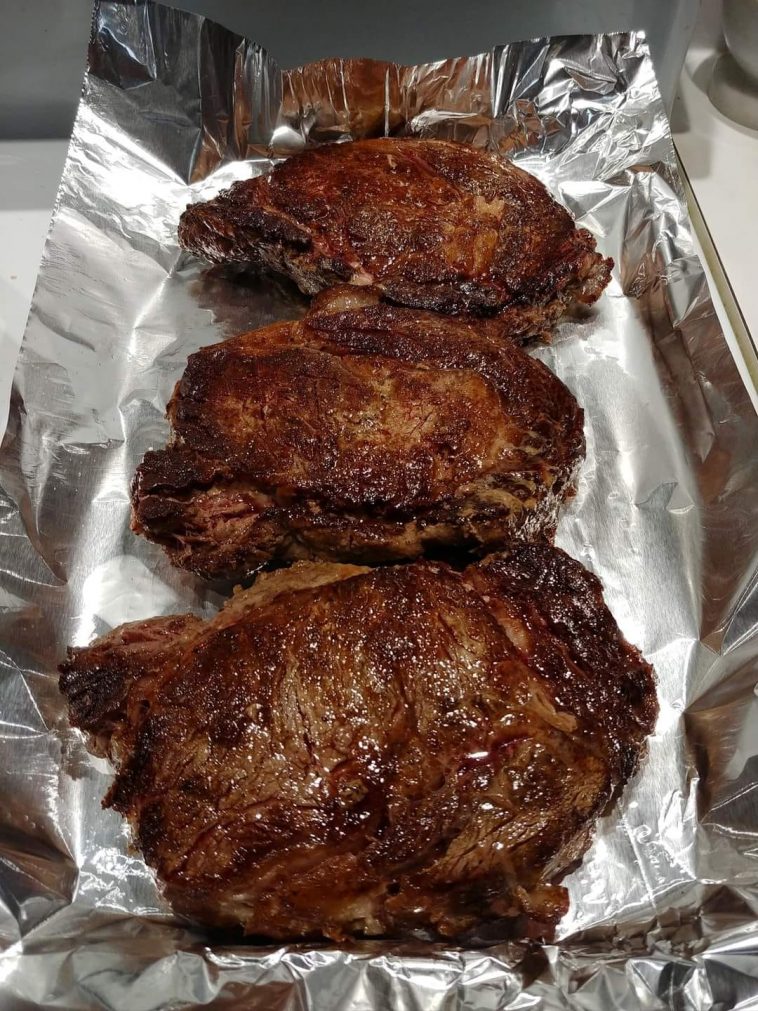
Rib-eye, sometimes called Scottish tenderloin or rib eye, is one of the most popular steaks in the world. It comes from the Longissimus Dorsi muscle, which runs along the spine and doesn’t overwork, giving it a nice, tender texture. What really sets it apart, however, is all the wonderful marbled fat that runs through the meat (including an “eye” of fat in the middle, hence the steak’s name), which, when cooked, melts and blends into the steak. This gives an extra beefy flavor and a juicy, moist, tender texture.
A prime rib can come from the sixth through twelfth ribs, and the end it comes from should dictate how it is cooked. The center cut is the most common (and is often what you’ll find when you buy a prime rib in a supermarket). It contains some of the fat cap and a good amount of marbling. Then we have the two ends: the short loin and the chuck. The short loin end contains little or no fat and less marbling, which is more suitable for people who prefer a less fatty meat. The chuck end, on the other hand, is more marbled and has most of the cap. To get the most flavour from a prime rib, ask your butcher for steaks cut from the chuck end.
Ingredients
1 rib steak
sea salt flakes
freshly ground black pepper
50 g butter
2 sprigs of thyme
1 clove of garlic crushed with its skin
Instructions
Take the steak out of the refrigerator at least half an hour before cooking so that it reaches room temperature. This is an important step to ensure even cooking of the steak.
When you are ready to cook, season the steak generously. Sprinkle it with plenty of salt and pepper on both sides, placing it high up for even coverage.
Heat your frying pan. If you’re cooking two steaks, make sure your pan is big enough for the steaks to fit comfortably. Otherwise, use two skillets and heat them simultaneously. Add the steak to the pan and cook over medium-high heat for 2 to 3 minutes on each side (depending on thickness and desired doneness). As a guideline, a 3 cm thick steak should be cooked through after 5 minutes. If you have a meat thermometer, the internal temperature should be 50°C for rare, 60°C for medium and 70°C for well done.
After turning the steak over for the first time, add the butter with the thyme and garlic and baste for one minute. To do this, tilt the pan towards you so that the butter collects at the bottom of the pan, then pour the butter over the steak repeatedly.
Remove the steak from the pan and let it rest for 5 minutes. Don’t be tempted to skip this step, as it is important. During the cooking process, the meat particles tighten, so if you slice the steak immediately after cooking, all the juices will run out onto the board. The resting time allows the particles to relax and reabsorb their liquids, which means you won’t lose those delicious juices when slicing.
Slice the steak across the grain, season and serve with your choice of sides and sauce.

Such a great recipe! I love it because you can cook it indoors and use a meat thermometer. Thanks for sharing ❤️.
Gotta try this recipe
I will try this!
Kudos to your Dan’s cooking!! Thanks for sharing; it looks yummy!!!!😋😋
I will try this
I do not understand 50 G butter. 3 cm or 50 C. Could someone please interpret this for me. Thank you
50 grams, 3 centimeters, 50 degree celcius
In US. Measurements please
Google grams to ounces and put in your numbers and it will convert it for you. The internet is full of calculators to do this
The pic shows it on alum foil so I thought it would be a different recipe
50 grams = 1.73 oz or 3.68 tablespoons of butter, 3 Centimeters =1.20 Inches, 50° Celsius is equal to 122° Fahrenheit, 60 °C = 140 °F